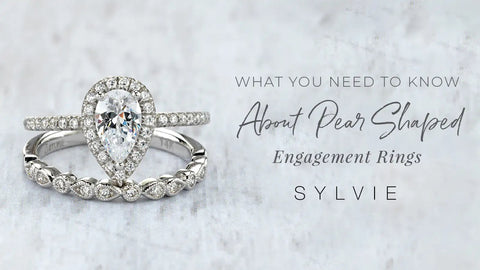A Guide to Pear-Shaped Engagement Rings: What you need to know
PEAR-SHAPED ENGAGEMENT RINGS ARE GAINING MASSIVE POPULARITY, AND IT IS EVIDENT WHY. NOT ONLY ARE THESE TEARDROP-SHAPED PIECES STUNNING, EYE-CATCHING, AND TIMELESS, BUT THEY ALSO OFFER YOUR FINGER AN ELONGATED AND FLATTERING LOOK. ADDITIONALLY, REGARDLESS OF THE SIZE OF THE STONE, A PEAR-SHAPED DIAMOND IS TAILORED TO OFFER A LITTLE MORE SPARKLE THAN OTHER SHAPES. IF YOU’RE MULLING OVER WHETHER YOU SHOULD OPT FOR A PEAR-SHAPED ENGAGEMENT RING, THIS GUIDE CAN HELP YOU MAKE THE RIGHT CHOICE.
PEAR-SHAPED ENGAGEMENT RINGS: WHAT ARE THEY?
Shaped in the form of an elongated teardrop, pear-shaped engagement rings are a combination of oval-cut and marquise-cut gems. With a myriad of options available, pear-shaped engagement rings are suitable for various aesthetics. From vintage-inspired styles to minimal solitaires, these are just the basic varieties of pear-shaped engagement rings. You can also find many pear-shaped gems in unconventional settings, such as double-band or cluster rings.
HISTORY OF PEAR-SHAPED RINGS
Also known as teardrops, pear-shaped diamonds are timeless shapes that are designed to maximize brilliance. This shape is more than 500 years old. It has grown and evolved over the years, adapting to the ever-changing need for modern touches. Pear-shaped rings were born from the marquis shape and were innovated from there onwards. Due to its evolving chic style and design, pear-shaped rings are one of the most coveted shapes for wedding and engagement rings.
CONSIDERATIONS FOR PEAR-SHAPED DIAMOND RINGS
It is important to understand and consider the 4C’s (color, cut, clarity, and carat) when buying any diamonds. Although this applies to pear-shaped diamonds as well, there are a few additional considerations that you need to make when selecting a beautiful ring with a brilliant pear-shaped stone.
SYMMETRY
When it comes to pear-shaped diamonds, symmetry is an imperative factor to consider. When determining the symmetry of this diamond, picture the top of the gem, then imagine a vertical line cutting through its center. If the diamond is cut perfectly in a symmetrical manner, then the shapes on each side of the line will flawlessly mirror one another. If a pear-shaped diamond lacks symmetry, it will be very visibly “off.”
PROPORTIONS
The proportion or the length-to-width ratio of a diamond is another important factor to consider when buying a pear-shaped diamond. Unlike symmetry, there isn’t one specific way to determine the best length-to-width ratio of a pear-shaped stone. This factor depends on the personal taste and preference of the buyer. Pear-shaped diamonds can be short and wide or long and thin. The more the length-to-width ratio, the slimmer and longer the stone will be.
THE “BOW-TIE” EFFECT
Unlike other cuts, pear-shaped diamonds have an aspect known as the “bowtie” effect. This means that the cut results in a darkened area in the center of the diamonds, forming the shape of a bowtie. However, the visibility of this bowtie is highly variable, depending on how well the diamond is cut. A well-cut pear-shaped stone will have an almost invisible bowtie effect, while a poorly cut stone will make this effect very obvious.
All in all, pear-shaped rings are stunning, elegant, and very unique. This shape is perfect for those searching for something beautiful yet distinct. Find the perfect pear-shaped diamond ring that accentuates your finger, and you’ve got yourself a timeless piece for life.




